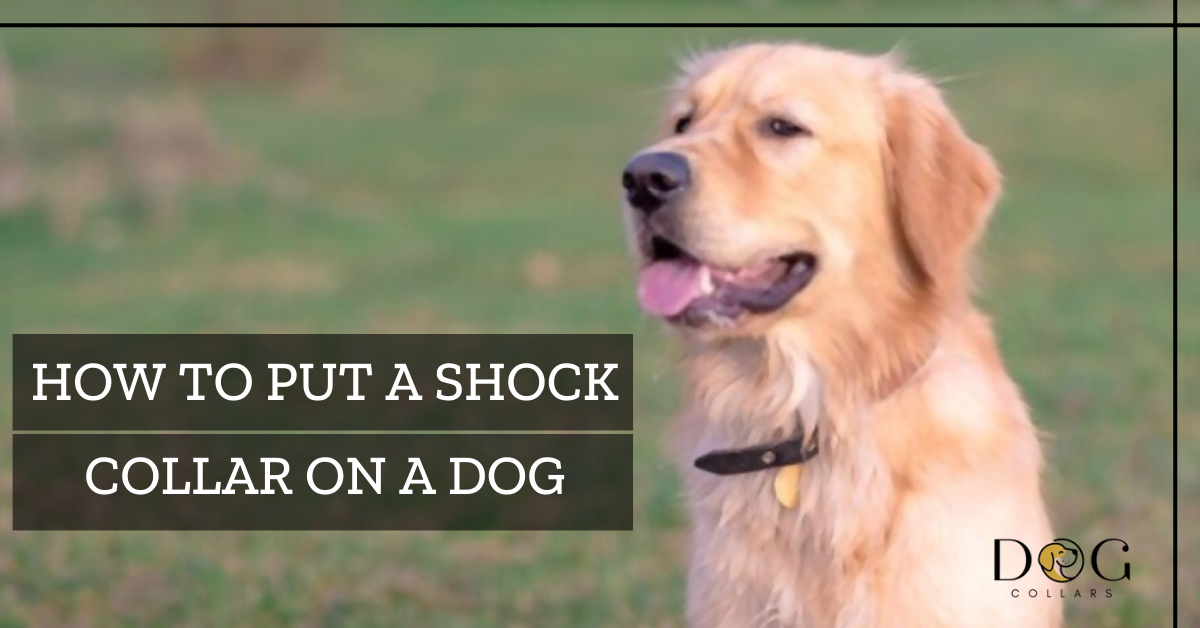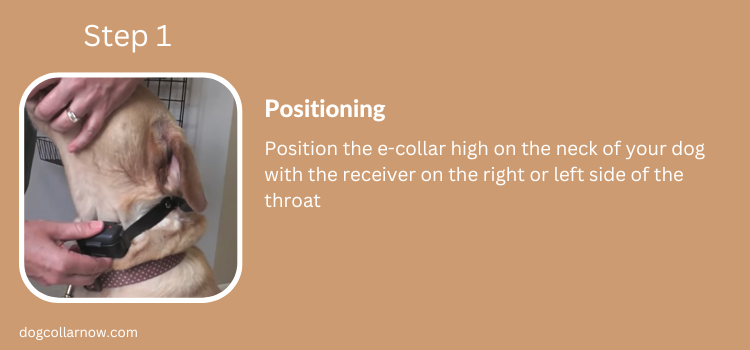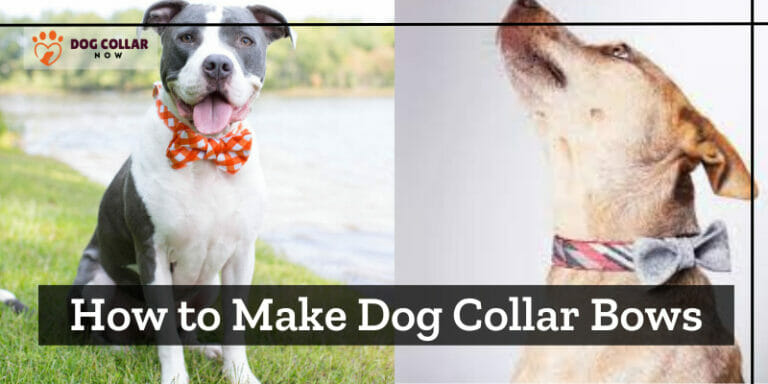How To Put A Shock Collar On A Dog – 3 Expert Tips

As a dog owner, I always strive to provide the best care for my furry friend. However, there are times when I need to correct my dog’s behavior, especially when it becomes dangerous or harmful. That’s why I decided to try using a shock collar.
Using a shock collar to train your dog requires patience and expertise. Make sure that you have an appropriate-sized collar for your dog. Follow the collar’s instructions to properly fit it around the neck of your dog. Attach the collar’s receiver to the e-collar and ensure that it is secure.
Let’s explore how to put a shock collar on a dog a proper way, so you can make the most of your remote dog trainer and training sessions.
How To Put A Shock Collar On A Dog – Preparation
A remote training e-collar isn’t complicated, but it’s easy to use it the wrong way. The receiver goes on a strap that wraps around the neck of your dog like a belt. It’s simple, but it’s important to make sure it is tight enough to avoid any problems.
If your e-collar isn’t working as expected or your dog seems to be in pain, it could be due to an incorrect fit. Take the time to research and prepare properly before using an e-collar on your pup. Don’t give up on the idea just yet!
Proper E-Collar Fit
Getting the perfect fit for your dog’s e-collar is crucial for effective dog training. To ensure consistent stimulation, make sure the collar fits snugly and the contact points rest against the skin.
Here are some steps for proper e-collar fit:
Positioning:
Position the e-collar high on the neck of your dog with the receiver on the right or left side of the throat.

Tightening:
Tighten the training collar strap to prevent it from sliding around.

Checking the Fit:
Check the fit by ensuring the contact points touch the skin and you can insert two fingers between the strap and the neck.

Finding the Perfect Training Tool: Factors to Consider
When it comes to choosing the right shock collar for your dog, there are a few important factors you’ll want to consider.
- First and foremost is the size of your dog. You don’t want a collar that’s too big or too small, as this can be uncomfortable or even dangerous for your furry friend.
- Another factor to consider is the type of training you’re hoping to achieve with the shock collar. Some collars come with different settings and modes, such as vibration or beep options in addition to shocks. So if you’re looking for a more versatile option, these might be worth considering.
- It’s also important to choose a reliable brand when shopping around for shock collars. Look for companies that have good reviews and offer warranties on their products.
- Think about how often you’ll be using the collar before making a purchase. If it’s something you only plan on using occasionally, then investing in an expensive model may not be necessary.
By taking all of these factors into consideration, you can make an informed decision when it comes time to choose which shock collar is best suited for your furry friend’s needs.
Things to Remember
Hey there, fellow dog owner! When using an e-collar on your fluffy friend, it’s important to make sure it fits just right. Here are some things to keep in mind:
- Don’t place the collar too low or too tightly, as it can cause discomfort or even sores.
- Rotate the collar every 2 hours to prevent irritation or discomfort.
- Don’t attach a leash to the e-collar, and make sure to only use it for 8-10 hours a day.
- If your dog has thick hair, longer touch points might be needed, or you can shave the area where the points will touch.
- Keep the e-collar and your dog clean and dry for the best results.
Remember, one properly fitted e-collar is essential for successful training, so take the time to make sure it’s snug but not too tight. Your pup will thank you!
What Else Can You Teach Your Dog Using a Shock Collar?
As a dog owner, you may wonder what else you can teach your furry friend using a shock collar. Well, collars can be used for a variety of training purposes such as basic obedience, boundary training, and behavior modification. But, it’s important to use this tool properly and under the guidance of a professional trainer.
Using a collar incorrectly can harm the physical and emotional health of your dog, so it’s crucial to consider other training methods like reward-based training first. Always make sure your dog is safe and well-being.
What Are The Dos And Don’ts When Using A Dog Shock Collar?
Dos:
- Seek professional guidance before using an E-collar on your dog.
- Start with positive reinforcement training before introducing a collar.
- Identify and target specific behaviors you want to correct.
- Adjust the collar’s intensity level according to the dog’s size and temperament.
- Use the collar for training purposes only and not as a permanent solution.
- Use the collar for short training sessions.
- Use a shock collar along with praise and recognition to reinforce good behavior.
- Be patient and consistent with the training process.
- Ensure the collar fits properly and is not causing any discomfort or harm to your dog.
- Regularly check and clean the collar’s contact points to avoid skin irritation.
Don’ts:
- Don’t use a dog collar on a puppy or a dog younger than six months old.
- Don’t use a collar as a punishment tool.
- Don’t use the collar for excessive barking or other minor behavioral issues.
- Don’t leave the collar on your dog for extended periods of time.
- Don’t use the collar on aggressive or fearful dogs.
- Don’t use the collar on dogs with health or behavioral issues without consulting a vet or a professional trainer.
- Don’t use the collar around the clock or as a permanent solution.
- Don’t use the collar on multiple dogs at once.
- Don’t use the collar if your dog is already stressed or anxious.
- Don’t use the collar to replace it with other training.
Conclusion
Using a Shock/Electronic collar on a dog requires careful usage and consideration. Positive reinforcement should be paired with it, and professional trainer consultation is recommended. Proper collar fitting and selection are crucial. Shock collars should be used for specific training purposes only and not as a permanent solution. Dog owners should prioritize the safety of the dog and their well-being, and use patience and consistency in training.
FAQs
What is the best point of contact for my dog?
Consider your dog’s coat length when choosing contact points. Long hair or thick coats require longer touch points of at least ¾”. Brush your dog regularly to remove loose hair around the neck area. Not only does this prevent matting and discomfort for your dog, but it also ensures that the place collar is correctly and securely, reducing the risk of it slipping or becoming ineffective.
How Does a Shock Collar Work?
A shock collar delivers an electric charge around your dog’s neck when triggered by a remote control. It’s meant to get the dog’s attention and discourage unwanted behavior, but it should only be used as a last resort and under a professional dog trainer to avoid causing harm.
What are the proper ways to train a dog using a shock collar?
To properly train a dog with a shock collar, seek professional guidance and start with positive reinforcement. Identify the specific behavior to address and use low-level intensity. Always reward good behavior and never leave the collar on all the time. Use this tool carefully and responsibly, and prioritize your dog’s safety and well-being.
How can a remote collar be used to stop bad behavior in dogs?
A remote collar can be used to stop bad behavior in dogs. Start by identifying the behavior you want to address and use the collar to deliver a low-level electric shock. Gradually increase the intensity if needed, but always use positive reinforcement techniques as well. Use this tool carefully and under professional guidance to avoid harming your dog.
How tight should a shock collar be?
An electronic dog training collar should be snug but not too tight around a dog’s neck. You should be able to fit one or two fingers between the collar and your dog’s skin.
Are vibrating collars cruel?
Vibrating collars, or shock collars, are controversial and potentially harmful to dogs. They can cause physical and psychological harm, including anxiety, aggression, fear, discomfort, irritation, and burns. Reward-based training is a more effective and compassionate alternative, endorsed by animal welfare experts, organizations, and veterinarians.






